|
| |
A Key for Every Character
QUESTION:
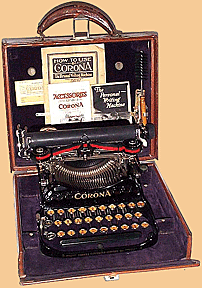 My
grandfather had an old Corona portable typewriter which he left to me.
It’s a small machine with the No. 3 on the rim below the space bar. I
believe the serial number is 125512. I’ve looked for some information on
it but haven’t found much. Can you tell me more about it? My
grandfather had an old Corona portable typewriter which he left to me.
It’s a small machine with the No. 3 on the rim below the space bar. I
believe the serial number is 125512. I’ve looked for some information on
it but haven’t found much. Can you tell me more about it?
Thanks,
Carol
______________________________________________________
ANSWER:
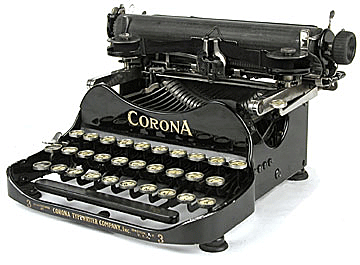 Your
typewriter dates from the second half of 1917 and is part of a long
line of machines created to make writing easier. It began in 1714
when Queen Anne of England granted a patent to Henry Mill for a
writing device that enabled the blind to write. Italian inventor
Pellegrino Turri created his own version of a typewriter in 1808,
along with carbon paper to provide the ink for his machine. Your
typewriter dates from the second half of 1917 and is part of a long
line of machines created to make writing easier. It began in 1714
when Queen Anne of England granted a patent to Henry Mill for a
writing device that enabled the blind to write. Italian inventor
Pellegrino Turri created his own version of a typewriter in 1808,
along with carbon paper to provide the ink for his machine.
In 1829, William Austin Burt patented a machine called the
"Typographer" on which he produced a letter to Secretary of State
Martin Van Buren. But even in the hands of its inventor, this
machine was slower than handwriting, preventing Burt and his
promoter John D. Sheldon from ever finding a buyer for the patent.
The typographer used a dial, rather than keys, to select each
character and resembled the squeeze-style label makers of the 1970s.
It wasn’t until 1843 that Charles Thurber invented a machine that
operated in way similar to modern typewriters.
It was 1843 before Charles Thurber came up with a rather slow untidy
machine that actually typed in a manner recognized today. A number
of inventors working independently or in competition with each other
over several decades came up with a variety of machines that
resemble the typewriters people used to use.
Rev. Rasmus Malling Hansen of Denmark invented the Hansen Writing
Ball in 1865. It went into commercial production in 1870 and became
the first commercially sold typewriter. He made a porcelain model of
the keyboard and experimented with different placements of the
letters, attaching the letters to short pistons that went through
the ball and down to the paper to achieve the fastest writing speed.
By placing the letters so the fastest writing fingers struck the
most frequently used letters, Hansen made his Writing Ball the first
typewriter to produce text faster than a person could write by hand.
In 1867, Christopher Latham Sholes invented the first practical
typewriter. Commercially known as "The Type-Writer," it had a
moveable carriage, a lever for turning paper from line to line, and
a keyboard similar to that of a piano with two rows of black walnut
keys with letters printed in white—capital letters only along with
numbers 2-9, a comma and a period. Sholes also created the QWERTY
keyboard layout to prevent frequent jamming of frequently used
letters.
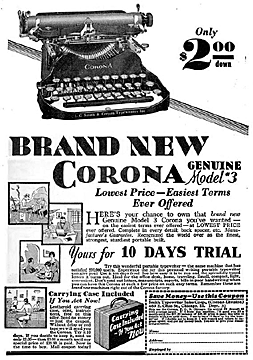 Philo
Remington of the Remington Arms Co. manufactured the first
marketable Sholes machine in 1874. He sold only eight the first year
at $125 each. And after four years he had only sold 5,000. Three
businessmen bought and reinvigorated the company under the name of
the Remington Typewriter Company in 1878. Philo
Remington of the Remington Arms Co. manufactured the first
marketable Sholes machine in 1874. He sold only eight the first year
at $125 each. And after four years he had only sold 5,000. Three
businessmen bought and reinvigorated the company under the name of
the Remington Typewriter Company in 1878.
The machines—whether the fancy "sewing machine" model with a treadle
to work the carriage or the unwieldy tabletop model—were still
costly. Inexperienced operators found the process more
time-consuming than writing. The biggest battle was people’s
resistance to change.
When in 1881 the New York YWCA offered typing lessons to girls, there
were protests that said the "delicate female constitution" couldn't
handle the six-month trial. But soon girls in high school were
taking typewriting courses.
The history of the Corona typewriter is similar to these other early
models. The four Smith brothers— Lyman Cornelius, Wilbert, Monroe,
and Hurlburt—opened the Smith Premier Typewriter Company in 1886.
They produced the first typewriter to use both uppercase and
lowercase letters using a double keyboard. The advertisements for
their new machine proclaimed that it had "a key for every
character."
The girl typist soon became the symbol of women's emancipation,
"David L. Cohen wrote in his 1940 book The Good Old Days. And when
typing merged with shorthand the female office worker became
invaluable. By 1900, Cohen noted, 206 women out of every 1,000 over
the age of 16 were employed in business and services, with
stenographers earning from $10-20 a week.
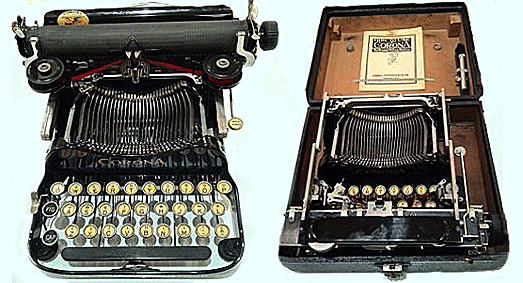
Nonetheless, the typewriter was an idea whose time had definitely
come. "We live at railroad speed in the nineteenth century, and all
aids which enable us to do the work of life well and quickly should
be recognized and adopted when feasible," Cassell's Family Magazine
proclaimed in 1888. And that's just what happened. Prices slowly
adjusted, as did the size and accessibility of the typewriter with a
burst of improved models and determined manufacturers onto the
business scene.
During 1906, the Rose Typewriter Company of New York City marketed
the first successful portable typewriter. The Smith brothers bought
the company in 1909, renamed it the Standard Typewriter Company, and
moved its headquarters to Groton, New York. And with the success of
their Corona model No. 3 in 1914, the firm became the Corona
Typewriter Company.
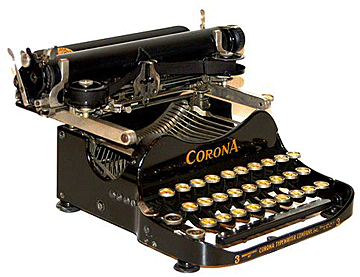 By
that time, the design of the mechanical typewriter had become
standardized. While there were minor variations from one
manufacturer to another, most typewriters had keys attached to a
typebar that had the corresponding letter molded, in reverse, into
its striking head. When the operator struck a key briskly and
firmly, the typebar hit an inked ribbon, making a printed mark on
the paper wrapped around a cylindrical platen mounted on a carriage
that moved left or right, automatically advancing the typing
position horizontally after the operator typed each character. The
carriage return lever advanced the paper vertically for each line of
text as it rolled around the platen. By
that time, the design of the mechanical typewriter had become
standardized. While there were minor variations from one
manufacturer to another, most typewriters had keys attached to a
typebar that had the corresponding letter molded, in reverse, into
its striking head. When the operator struck a key briskly and
firmly, the typebar hit an inked ribbon, making a printed mark on
the paper wrapped around a cylindrical platen mounted on a carriage
that moved left or right, automatically advancing the typing
position horizontally after the operator typed each character. The
carriage return lever advanced the paper vertically for each line of
text as it rolled around the platen.
 By
about 1910, the "manual" or "mechanical" typewriter had reached a
somewhat standardized design. There were minor variations from one
manufacturer to another, but most typewriters followed the concept
that each key was attached to a typebar that had the corresponding
letter molded, in reverse, into its striking head. When the typist
struck a key briskly and firmly, the typebar hit a ribbon, usually
made of inked fabric, making a printed mark on the paper wrapped
around a cylindrical platen. The platen was mounted on a carriage
that moved left or right, automatically advancing the typing
position horizontally after each character was typed. The paper,
rolled around the typewriter's platen, was then advanced vertically
by the "carriage return" lever into position for each new line of
text. By
about 1910, the "manual" or "mechanical" typewriter had reached a
somewhat standardized design. There were minor variations from one
manufacturer to another, but most typewriters followed the concept
that each key was attached to a typebar that had the corresponding
letter molded, in reverse, into its striking head. When the typist
struck a key briskly and firmly, the typebar hit a ribbon, usually
made of inked fabric, making a printed mark on the paper wrapped
around a cylindrical platen. The platen was mounted on a carriage
that moved left or right, automatically advancing the typing
position horizontally after each character was typed. The paper,
rolled around the typewriter's platen, was then advanced vertically
by the "carriage return" lever into position for each new line of
text.
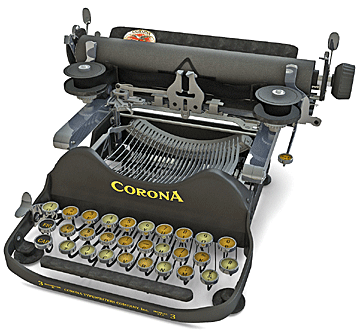 Manufacturers
inked some ribbons in black and red stripes, each being half the
width and the entire length of the ribbon. A lever on most machines
allowed switching between colors, which was useful for bookkeeping
entries where negative amounts had to be in red. Manufacturers
inked some ribbons in black and red stripes, each being half the
width and the entire length of the ribbon. A lever on most machines
allowed switching between colors, which was useful for bookkeeping
entries where negative amounts had to be in red.
A significant innovation was the shift key. This key physically
"shifted" either the basket of typebars, in which case the
typewriter is described as "basket shift", or the paper-holding
carriage, in which case the typewriter is described as "carriage
shift." Either mechanism caused a different portion of the typebar
to come in contact with the ribbon/platen. The result is that each
typebar could type two different characters, cutting the number of
keys and typebars in half and simplifying the internal mechanisms
considerably. The obvious use for this was to allow letter keys to
type both upper and lower case, but normally the number keys were
also duplexed, allowing access to special symbols such as percent
(%) and ampersand (&).
Until recently, antique dealers considered old typewriters
worthless, but prices of them on eBay have begun to climb. Of
course, higher prices only appear for the most unique models in
excellent condition. A Corona No. 3 model from 1917 ranges in price
on eBay from about $50 to $190 without its case and $400 for one
with its case.
<
Back to Readers Ask Archives
Next Article > |
|

|
|
FOLLOW MY WEEKLY BLOG
Antiques Q&A
JOIN MY COLLECTION
Antiques and More
on Facebook
LIKE MY FACEBOOK PAGE
The Antiques
Almanac on Facebook |
|
No antiques or collectibles
are sold on this site.
|
|
How to Recognize and
Refinish Antiques for Pleasure and Profit
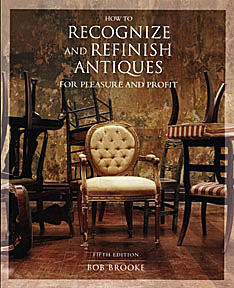
Have
you ever bought an antique or collectible that was less than perfect and
needed some TLC? Bob's new book offers tips and step-by- step
instructions for simple maintenance and restoration of common antiques.
Read an
Excerpt
|
|

|
|
|
|
|
